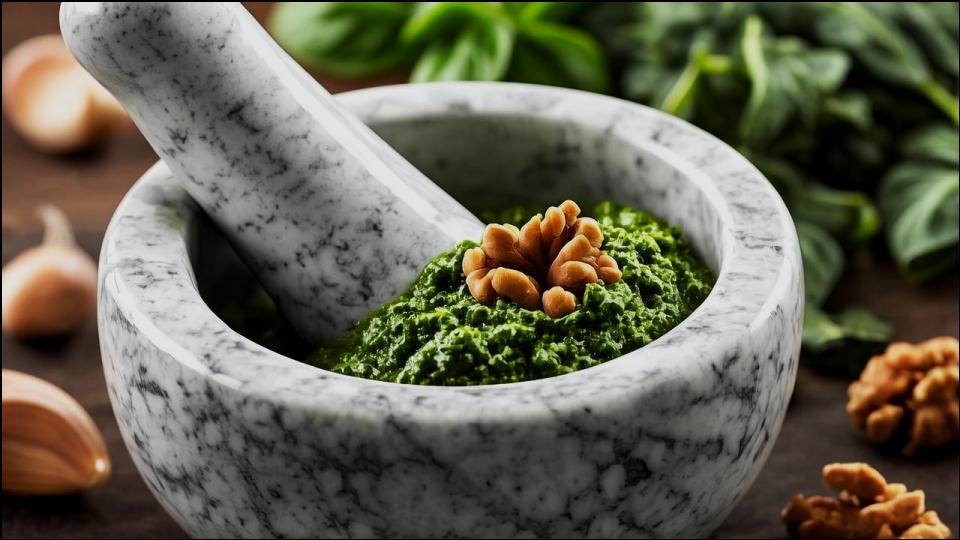A surge in the cost of traditional ingredients, coupled with climate-induced agricultural pressures, is compelling chefs and home cooks to rethink the classic pesto recipe. This shift in pesto ingredient sourcing is transforming the iconic Italian sauce, moving beyond its rigid traditions and fostering culinary innovation driven by economic and environmental necessity.
The primary challenge lies in the escalating price and volatile supply of pine nuts and, to a lesser extent, high-quality basil and olive oil. This has led to a widespread adoption of alternative nuts, seeds, and greens, fundamentally altering one of Italy’s most famous culinary exports.
The Soaring Cost of a Classic
The iconic pesto alla Genovese, traditionally made with Genoese basil, pine nuts, Parmesan cheese, Pecorino cheese, garlic, salt, and Ligurian olive oil, faces significant economic headwinds. The main driver of this pressure is the price of pine nuts, which have been subject to market volatility for years.
According to a 2023 market analysis by Mintec, a global provider of commodity price data, pine nut prices have remained stubbornly high due to a combination of factors. These include long harvesting cycles, labor-intensive collection processes, and geopolitical disruptions in key exporting countries like China and Russia.
“Pine nuts are one of the most expensive nuts in the world due to the time and labor required to harvest them,” said Dr. David Hughes, an emeritus professor of food marketing at Imperial College London, in a recent industry brief. “The trees can take up to 25 years to produce cones, and the extraction process is delicate. Any disruption, be it from climate or trade policy, has an immediate and significant impact on global prices.”
Furthermore, climate change poses a direct threat to traditional basil cultivation. A report from the Italian Ministry of Agricultural, Food and Forestry Policies noted that unpredictable weather patterns, including increased heatwaves and water scarcity in regions like Liguria, are challenging the consistent production of the prized Basilico Genovese D.O.P. (Protected Designation of Origin).

Rethinking Tradition: The Rise of Pine Nut Alternatives
In response to these challenges, the culinary world is embracing a more flexible approach to what constitutes authentic pesto. Many high-end restaurants and food manufacturers are now using pine nut alternatives to manage costs and ensure product consistency without sacrificing the sauce’s gourmet appeal.
Walnuts and almonds have emerged as the most popular substitutes. Their creamy texture and milder, earthy flavors blend well with basil and garlic. America’s Test Kitchen, a prominent culinary research organization, found that lightly toasting walnuts before blending can neutralize their slightly bitter tannins, making them an excellent replacement.
“The secret is not about finding an exact replica for pine nuts, but about finding a complementary flavor profile,” wrote Samin Nosrat in her James Beard Award-winning book Salt, Fat, Acid, Heat. She notes that the foundational role of the nut is to provide a creamy, fatty emulsion, a role that other nuts or even seeds can successfully fill.
Other popular alternatives include:
- Pistachios: Offer a vibrant color and a distinct, slightly sweet flavor.
- Cashews: Provide a rich, buttery texture, resulting in a smoother pesto.
- Sunflower and Pumpkin Seeds: A nut-free option that offers a mild flavor and is significantly more cost-effective.
Sustainable Agriculture and a New Generation of Greens
The innovation extends beyond nuts. The principles of sustainable agriculture and reducing food waste have encouraged chefs to look past basil for the green base of the sauce. Arugula, kale, spinach, and even carrot tops are now commonly used.
These alternative greens not only lower the cost but also introduce new flavor dimensions. Arugula adds a peppery bite, while spinach offers a milder, more earth-forward taste. Using often-discarded parts of vegetables like carrot tops or beet greens aligns with a root-to-leaf cooking philosophy that is gaining traction globally.
“This is about adapting to what is fresh, local, and available,” said Massimo Bottura, an Italian restaurateur and advocate for sustainable cooking, in a speech at the United Nations. “A traditional recipe is a snapshot of a time and a place. The spirit of Italian cooking is to use the best of what you have, and that is what we are seeing today.”
This adaptive mindset suggests that the “secret” to perfect pesto in the modern era is not a single ingredient but rather an intelligent and informed flexibility. By understanding the function of each component—the fatty richness of the nuts, the fresh aroma of the herbs, the salty bite of the cheese—cooks can make thoughtful substitutions that honor the spirit of the original while responding to contemporary realities.
As global supply chains continue to face pressure, the evolution of pesto may serve as a model for how other traditional dishes can adapt, ensuring their survival for future generations to enjoy. The recipe may change, but its essence as a fresh, vibrant, and versatile sauce remains constant.
Culinary Experts Agree: This Is the Optimal Method for Reheating Pasta


 How Quick Air Fryer Meals Are Reshaping the American Kitchen
How Quick Air Fryer Meals Are Reshaping the American Kitchen A Depression-Era Staple, Southern Tomato Gravy, Finds New Life in Modern Kitchens
A Depression-Era Staple, Southern Tomato Gravy, Finds New Life in Modern Kitchens Why a Forgotten 1950s Cake with a Secret Ingredient Is Trending Again
Why a Forgotten 1950s Cake with a Secret Ingredient Is Trending Again More Than a Dessert: How Tar Heel Pie Captures the Essence of North Carolina
More Than a Dessert: How Tar Heel Pie Captures the Essence of North Carolina